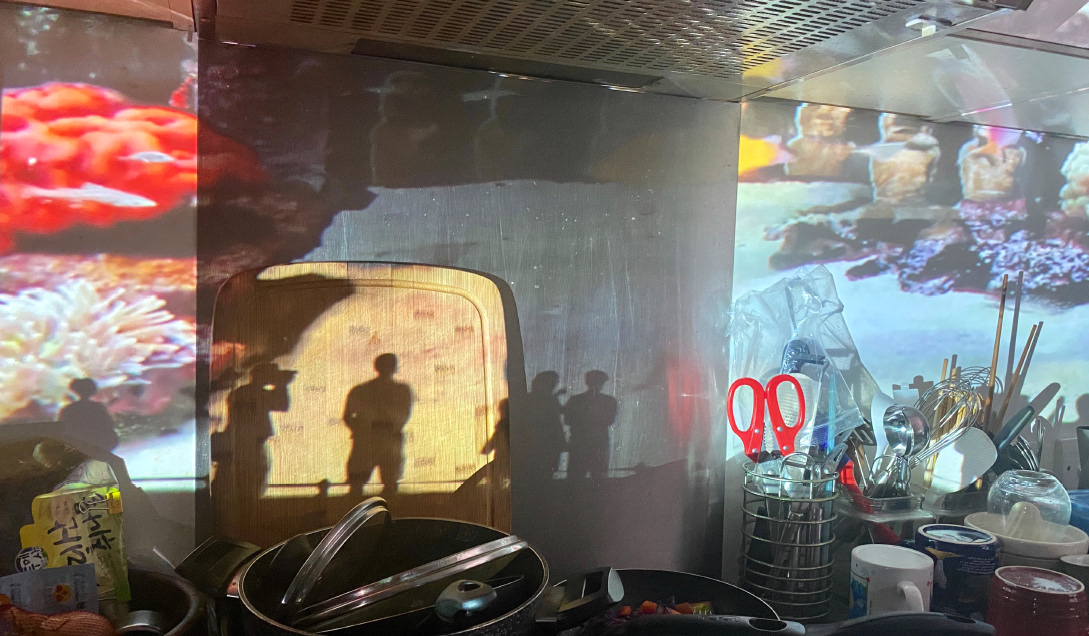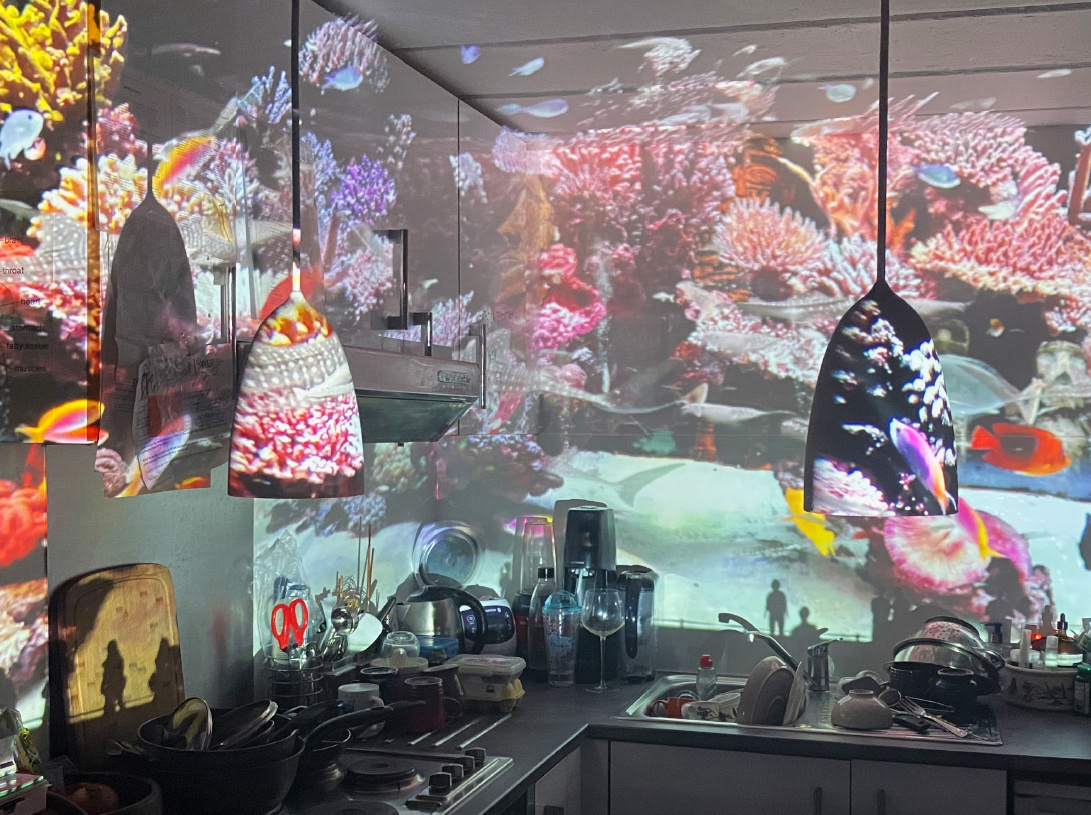at Towards Meta_Garden, Gwangju Museum of Art, Gwangju, Korea, 15 JUL - 31 OCT, 2021
at Among the Garbage and the Flowers, Le6b, Paris, France, 10 - 23 OCT, 2021
at Among the Garbage and the Flowers, Le6b, Paris, France, 10 - 23 OCT, 2021
"Whilst living next to Greenwich Observatory in London, the prime meridian, I wondered every night. What is happening on the other side of the world, at the 180th parallel?
Can the attitude of setting this place—London—as the ‘beginning point’, the ‘standard’, possibly be justified?
Doesn’t the anthropocentric mentality of valuing science and reason already objectify the peripheral and justify inequalities?
Who lives in the South Pacific, on the other side of the globe? And how do they live?
Has our civilisation grown any closer to the ideal future that humanity has dreamt of?
And where in the world do the souls of the fish go? Are they here, with us still?"
Can the attitude of setting this place—London—as the ‘beginning point’, the ‘standard’, possibly be justified?
Doesn’t the anthropocentric mentality of valuing science and reason already objectify the peripheral and justify inequalities?
Who lives in the South Pacific, on the other side of the globe? And how do they live?
Has our civilisation grown any closer to the ideal future that humanity has dreamt of?
And where in the world do the souls of the fish go? Are they here, with us still?"
- from the artist note for MOANAIA by Jinjoon Lee
MOANAIA
Jinjoon Lee, Hohee Cho
People of Oceania were historically vulnerable to introduced epidemics. Earliest recorded epidemics in Oceania are found from the late 18th century. Captain Cook's visit to Tonga in 1773 and Spanish expedition to Tahiti in 1774 left marks of epidemics. Vancouver's trip introduced dysentery to Tahiti. Dysentery epidemic later spread to Fiji in 1791. In Tonga, two influenza epidemics occurred in 1773 and 1777 between Cook's expedition. Australian aboriginal people suffered smallpox epidemics in the 1780s. A terrible dysentery epidemic was recorded in Fiji between 1802 and 1803. Dysentery killed too many people in 1804 Hawaii that not all dead could be buried. A large proportion of aboriginal people in Australia were killed by smallpox between 1829 and 1831. Samoa recorded influenza epidemics in 1830. Pacific islanders were not immune to the European-introduced diseases. Measles was introduced to Oceania in 1834 by ships visiting Sydney. It spread to New Zealand to cause high mortality rates among Maori people. Hawaii was exposed to measles in 1848. Later in New Caledonia and Vanuatu, measles epidemics resulted in fatality rates up to 30%. Samoan people survived severe whooping cough epidemic in 1848 and mumps in 1850. In 1854, measles occurred in Australia to be introduced to Tahiti and Cook Islands. Another smallpox cost a substantial number of Australian aboriginal people in the 1860s. New Guineans experienced smallpox in 1872.
One of the most catastrophic epidemics in Oceania was the 1875 measles in Fiji. This can be traced to Fijian King's visit to Sydney following the cession of Fiji to the British Empire in 1874. The 1875 measles killed about 40,000 Fijians, nearly a quarter of the population. Fiji experienced continuous waves of epidemics. Ships carrying indentured labourers to work in sugar plantations arrived with smallpox and cholera from 1879. Influenza and whooping cough epidemics caused 3,000 deaths in 1883. Fiji lost 1,500 people for dengue fever, dysentery and influenza between 1885 to 1886. In 1901, another dysentery epidemic in Fiji cost about 3,000 lives. Fiji had another measles in 1903 that took away 3,000 people. In just 20 years since 1875, the Fijian population halved from 200,000 to 100,000.
Another deadly epidemic that swept Oceania was the 1918 pandemic influenza. It came from Europe after the First World War leaving highly lethal effects in Fiji, New Zealand, Nauru, Samoa, Tonga and Hawaii. Western Samoa lost 8,000 people from the influenza, resulting in loss of about 22% of the population. This was introduced by a New Zealand ship. Similarly, in Fiji 8,000 deaths were caused by the influenza resulting in deaths of 5.7% of native Fijians. The Pacific islands suffered tremendous loss by their contact with Europeans. The advent of the Second World War led to further violation of the lands and seas of Oceania. It was a war between white Europeans and white Asians fought not in their lands, but the Pacific islands. Bombs were dropped and jungles were chopped. The damage did not stop with the end of the Second World War. During the Cold War, Pacific islands were subject to testing nuclear weapons of American and French powers.
Under the sea surface, more lives have been lost since the 20th century. The damage extends to the marine environment of the wider Pacific area. Coral reefs, home to a quarter of the marine species, are killed by the rise of ocean temperature. At the Great Barrier Reef, mass bleaching took place in 1983, 1987, 1998, 2002, 2016, 2017 and will happen again in 2020. Only skeletons can be found in more than half of the Great Barrier Reef. The rise of ocean temperature also created the blob, a mass of marine heatwave in the Pacific Ocean since 2013. The blob caused a sudden drop in plankton population that led to the deaths of one million seabirds off the North American coast. Accordingly, thousands of sea lions, whales and puffins died due to disruption in the food chain. On the other hand, millions of starfish died off for warmer temperature and unidentified epidemic diseases. In Australia, 2018, ten thousand native fishes died off resulted from the drainage of rivers.


Moanaia
A beam projection view of kitchen in Lee's house, Oxford, 2020.
Description of Work
Jinjoon Lee’s visual installation art Moanaia is supported by the Art, Biodiversity and Climate Network of University of Oxford and is based on the research of Hohee Cho, who studies medical history at the Faculty of History, University of Oxford.
This art is an extension of Jinjoon Lee’s DPhil thesis on ‘Liminal Space’ that studies stairs, stages, and gardens. It delivers a virtual experience of an aquarium through its large screens. It also indirectly projects the technological development of contemporary world along with the culture and environment of Oceania, largely neglected in world history, which is centred on the northern hemisphere.
Moanaia is a compound word made of moana, meaning ‘large ocean’ in Polynesian, and -ia from Oceania. Made of small islands scattered across the South Pacific, It is a ‘liminal area’ where the 180th meridian is located. This area, almost appearing non-existent in the Atlantic-centred map, is difficult to travel to, although it takes up a massive space on earth. Its rather well-preserved environment is due to such paradoxical geographical character. On the other hand, this area has been experiencing severe illnesses since the age of empires, armed with technology, driven by anthropocentrism.
The video provides a strong immersive experience of the real world and the virtual space through the editing with visual AI technology. Wandering human shadows, objectified nature, and the history of Oceania represented by individual statues is posed together to ask an existential question on humanity’s utopia. Particularly, it questions the peril of science, technology, and civilization to the future environment.
Supported by Anya Gleizer Art, Biodiversity and Climate Network in the University of Oxford.
Data clustering and dimensionality reduction techniques to project the frames of the video into 2-dimensional space are associated to certain modification of the bubble sound.
Artist Jinjoon Lee
Co-Researcher Hohee Cho
Support
Gwangju Museum of Art
St. Ethelburga's Centre for Reconciliaton and Peace
TORCH
University of Oxford
Crousculture & Saint Denis
